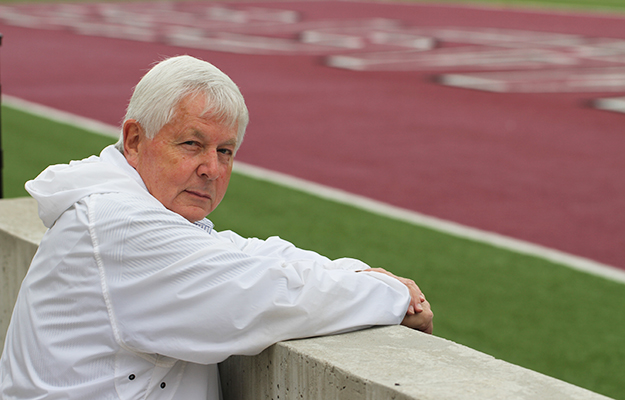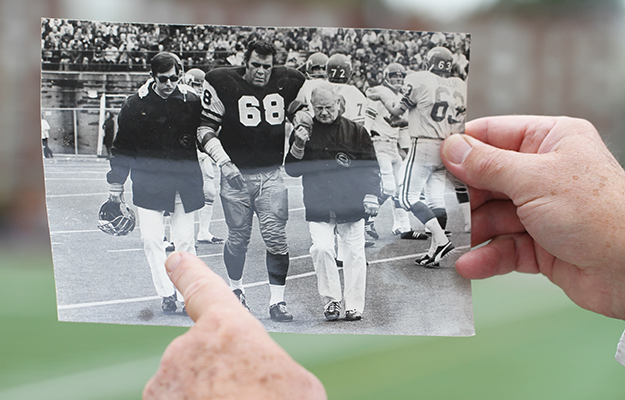A lifetime on the sidelines: Athletic Hall of Fame honours Robert Holmes

Calm and collected: Robert Holmes surveys the field at Ron Joyce Stadium, home to the McMaster Marauders since 2008. He'll be inducted into the University's Athletic Hall of Fame on Sept. 25.
One of Canada’s premier athletic therapists got into the profession on a whim, with no prior training.
Next Thursday, he’ll join the biggest names in McMaster sport history as part of the University’s Athletic Hall of Fame.
It’s an irony not lost on former head athletic trainer Robert Holmes, who could have just as easily taken a different path in life.
Back in the late-1960s, Holmes was seven years into a promising career as a shipper at Stelco — at the time, one of the largest employers and economic drivers in the city.
On weekends, he played amateur football and hockey with friends, and found himself spending more and more time observing the trainers and physicians tending to players in the dressing rooms.
One fateful afternoon in the spring of 1970, Holmes decided he’d like to try his hand at taping ankles and icing knees. He wandered over to the old Civic Stadium on Balsam Ave. N., home to the CFL’s Hamilton Tiger-Cats, and simply knocked on the front door.
“I knew I wasn’t going to play professionally, so I figured this was a way to remain involved in athletics,” says Holmes, who will be inducted into the Builder category on Sept. 25. “I convinced them to let me help the team as a volunteer, and they added me to the staff on a part-time basis the following season.”
By 1972, Holmes had a Grey Cup ring on his finger, a full-time job with the Tiger-Cats and a budding career in athletic therapy.
It wasn’t long before McMaster came calling.
Above: Robert Holmes (left) in the early-1970s, walking injured Tiger-Cat Angelo Mosca off the field.
Holmes joined the University in 1975 as an athletic trainer, and immediately began overseeing 19 intercollegiate teams and several thousand student-athletes. The demand was so huge, Holmes launched McMaster’s first student-trainer apprenticeship program, and began educating students the fine art of rehabilitating an athlete.
From day one, his methods were progressive. Holmes began a quest to expand and evolve the University’s athletic therapy resources.
“Back when I first started, we had three folding tables, an ice machine and a whirlpool,” says Holmes. “We needed to offer more. So I began bringing in local chiropractors and doctors to help treat the students.”
Student Health Services soon became involved, and Holmes’ team began offering athletic therapy from early in the morning to late at night. It was gruelling at times, but the results were immediate.
The idea was to reinvent the whole notion of athletic therapy. Rather than icing an injury, handing out two Advil and sending a student on his or her way, Holmes began charting recovery times and developing therapy routines to speed healing and prevent further injury. He measured students’ range of motion, and tailored each treatment to the individual student, sport and specific injury.
But there were dark times, too. Both on and off the field.
In March of 1981, local basketball referee Len Wright collapsed on the court at Burridge Gymnasium, and couldn’t be resuscitated by Holmes and a team of paramedics. He still has a clipping from The Hamilton Spectator detailing the tragedy.
“That was a very difficult night. I’ll never forget it,” he recalls. “I knew we had to do more, in order to prevent something like that from happening again. And we had to do it immediately.”
McMaster soon became the first university in Canada to have a defibrillator on standby, at Holmes’ insistence. He took courses at Hamilton’s General Hospital to get up to speed on the new technology, and quickly trained others.
His role at McMaster continued to evolve as well — full-time athletic therapist by day, and part-time counsellor when students needed someone to talk to, and someone they could trust.
By the late-1990s, Holmes decided to switch gears. Long hours on the job began to take a physical and mental toll, and it was time to move on and follow other passions — first scuba diving, and later teaching.
But when McMaster came knocking once more — this time for the Athletic Hall of Fame — it all came flooding back.
“Over the past few weeks, I’ve had more people call to congratulate me than ever before. It’s unbelievable,” said Holmes. “I’m very happy to receive this honour. I’m tickled pink.”
Holmes will be inducted alongside Frank Baines (Track & Field, Class of 1966), Sarah Dickson (Swimming, Class of 2001), Mathieu Whelan (Water Polo, Class of 2001), Phil White (Rugby Coach), the 1963 Cross Country Team and the 1962-63 McMaster Marlins Hockey Team.
The 31st annual Athletic Hall of Fame induction ceremony will take place Thursday, Sept. 25 in the Sport Hall, David Braley Athletic Centre. Doors open at 5:30 p.m.
Tickets to the induction ceremony can be purchased here.
Below: Holmes’ Grey Cup championship ring from the 1972 Hamilton Tiger-Cats.



